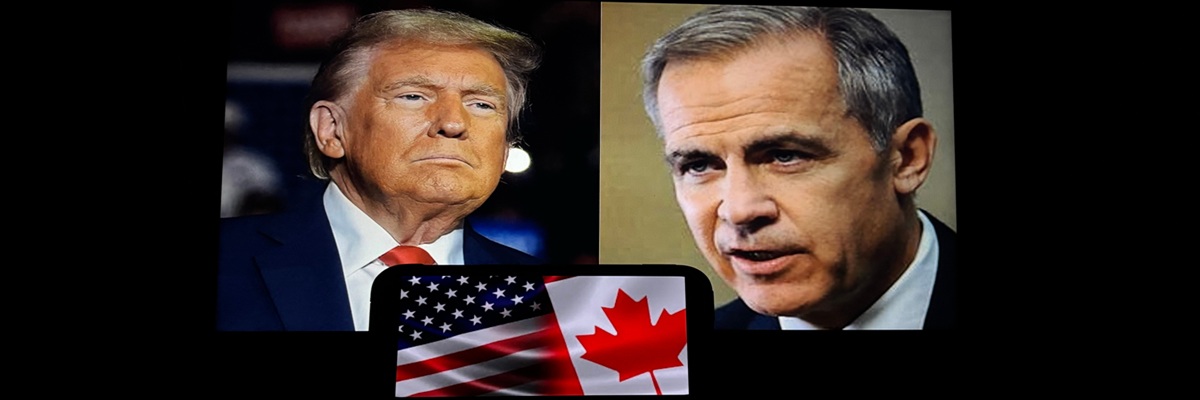Diplomacy
Canada on the way of change

Image Source : Shutterstock
Subscribe to our weekly newsletters for free
If you want to subscribe to World & New World Newsletter, please enter
your e-mail
Diplomacy

Image Source : Shutterstock
First Published in: Mar.13,2025
Apr.07, 2025
First months of the 2025 year were uneasy for Canada, it started with waves of changes. The era of Justin Trudeau, who was the leader of the country for 10 years from 2015 to 2025, and the beginning of the new presidential term of Donald Trump made things different for Canada and added uncertainty. On the ninth of march the new leader of the Liberal Party has been chosen, Mark Carney became the new prime minister of Canada. It remains unclear how long he will stay in his position, because Canada is standing on the threshold of federal elections.
The end of era
Like any leader, Justin Trudeau had certain achievements but also enough failures that affected the decline in his popularity among the population, lack of trust from fellow party members and opposition parties, which in the best years were even ready to collaborate with him together. In 2022 the New Democratic Party (NDP) and Liberal Party make an agreement to build trust and solidify a position on significant socio-economic issues. However, by the end of autumn 2024 the leader of the New democratic party Jagmeet Singh said that Justin Trudeau was not coping with the tasks facing the country and announced the NDP withdrawal from the agreement. This statement had a negative impact on the rating of the Liberal Party while they were passing decisions through Parliament. In the end of December Jagmeet Singh asked Justin Trudeau to resign and state that he is ready to support a vote of no confidence in the government, which the Conservative Party has been systematically calling for by that time. In the end of December of 2024 suddenly minister of finance and deputy prime minister of Canada Chrystia Freeland unexpectedly announced her resignation. This action raised a wave of negative sentiments around Justin Trudeau.
The greatest criticism of the Prime Minister was caused by the failed migration policy, shortage of housing stock coupled with the sharp increase in housing prices, high inflation, and unemployment and the introduction of unpopular carbon tax. As a result of severe pressure of fellow party members and leaders of opposition parties Justin Trudeau was forced to announce the resignation on 6th of January, from the moment when a successor will be found within the liberal party. At the same time, he noted that if he must wage and internal party struggle, he does not consider himself as a suitable candidate for the role of a leader for the party during the next elections.
Beginning of New Uncertainty
The era of political uncertainty in Canada worsened when Donald Trump repeatedly “attacked” the country’s sovereignty by verbally proposing Canada to become the 51st state of the United States. He also threatened to impose a 25% tariff on Canadian products, although he canceled this decision several times.
On December 1st, Donald Trump signed an executive order imposing a 25% tariff on products coming from Canada and a 10% tariff on energy from Canada. The U.S. stated that this was a measure to combat emerging threats due to high levels of migration and fentanyl trafficking across the U.S.-Canada border.
In response, Canada threatened to impose retaliatory tariffs on critically important minerals and fossil, electricity supplies, energy resources, and other products. Justin Trudeau, who was in the final days of his term, achieved some success during negotiations on February 3rd between Canadian and American leaders. As a result, Donald Trump agreed to postpone the imposition of tariffs on Canadian products for 30 days. This decision followed Canada’s promise to strengthen border security measures and invest an additional $1 million into those efforts.
The tariffs were imposed on March 4th, and Justin Trudeau responded with retaliatory measures targeting U.S. products. However, on March 5th, Donald Trump canceled the tariffs on the automobile industry, and on March 6th, after a phone call with the leaders of Mexico and Canada, he signed an executive order temporarily suspending tariffs on Canadian and Mexican products that comply with the terms of the USMCA (United States–Mexico–Canada Agreement).
If the tariffs were imposed in full, they would have had a negative impact on the Canadian economy. Supply chain channels would suffer, leading to an increase in the prices of various goods traded between Canada and the U.S. Additionally, the tariffs would reduce the competitiveness of Canadian products in the U.S. market. The most harmful consequences would be felt by sectors and products highly dependent on the American market.
Trust credit
The topics related to tariffs and bilateral agreements with the USA during the last two months became the main subject of discussion in Canada and in the main election campaign for the leader of the Liberal Party. On the 9th of March, the successor of Justin Trudeau was selected. It was Mark Carney, who received 85.9% of the votes. During the final stage, there were four candidates for the position of leader of the Liberal Party. The second after Mark was the Minister of Finance and Deputy Prime Minister of Canada, Chrystia Freeland. She did not get many votes, receiving only 8% of the votes from the electorate. The other two candidates — Karina Gould, the leader of the Government in the House of Commons, and Frank Baylis, who was a member of Parliament, received 3.2% and 3%, respectively.
The main topics of Mark Carney’s internal party campaign were the economic development of Canada, climate change, and a green incentive program. He proposed a carbon tax from consumers to large companies, removing trade barriers between Canadian provinces and territories, increasing the pace of housing construction and investments in this sphere while cutting the government budget.
The success of Mark Carney can be attributed to a few reasons. He is the only candidate who did not hold any official position in Justin Trudeau’s Cabinet and did not have a position in Parliament. So, he represents some distance from the course of the prime minister, which Canadians did not like during the post-pandemic times. Canadians associate Mark Carney with new opportunities and changes for Canada. He is not a person from politics; he is related to the economy and business sector. Among his numerous roles, he was the Governor of the Bank of Canada during the 2008 crisis, when Canada avoided the worst impacts due to good financial and banking policies. In 2013, he was appointed as Governor of the Bank of England. He handled the economic processes during Brexit and the following economic and political crises. This experience casts Mark Carney in a positive light for voters and provides him with trust during tough times in the country, marked by unfriendly statements and actions from the closest partner — the US.
Carney himself highlights his success in crisis management and believes that he would be able to negotiate with Trump, even though he agrees that the 25% tariff and policy that Trump has stated are a serious challenge in modern Canadian history. In his victory speech after being elected as the leader of the Liberal Party, he highlighted that: "The United States of America are not Canada. Canada will never become a part of the US in any form, in any way." All other political elites are in solidarity with him. Carney states that Canada must fight Trump’s tariffs using retaliatory measures in the form of "dollar for dollar." The main goal is the diversification of trade agreements in the medium term.
Both goals are important. For now, Canadian analysts are concerned that Trump’s tariffs in the short term may cause a recession in the Canadian economy. It is important to remember that Donald Trump is a businessman, and in political discussions, he has often said that he is ready for deals. Maybe Carney, with his experience in the economy and finance, will find a way to make such a deal — if he has time.
What is next?
For how long Mark Carney will stay in the prime minister position is hard to predict now. According to the schedule, another federal election in Canada should take place no later than October 2025, however, the Canada Elections Act provides the opportunity for long-term elections. There is a high probability that Mark Carney will use his popularity and announce voting in the next few weeks. According to the law, the pre-election period must last from 37 to 51 days.
The main opposition for Carney will be the leader of the Conservative Party, Pierre Poilievre. For the last 1.5 years, the rating of the Conservative Party has been significantly higher than the rating of the Liberal Party. According to the data, the popularity rate of the Conservative Party on January 6th was equal to 44.2%, and the Liberal Party had 20.1%. However, the rating of the Liberals started to grow after Justin Trudeau announced his resignation. According to the data on March 5th, the rating of the Conservative Party was equal to 40.3%, and the Liberal Party had 30.8%.
Pierre Poilievre, with his views, is close to the ideas of right-wing populism. He is a supporter of the Freedom Convoy — the protest movement that spread across Canada in early 2022. People often say that his positions and approaches are similar to those of Donald Trump. Even though the pre-election campaign has not officially started yet, Pierre Poilievre unofficially began his campaign in January.
After Justin Trudeau announced his impending resignation, Pierre Poilievre changed his political slogan “Axe the Tax” (which referred to the unpopular carbon tax) to “Canada First,” which is similar to Trump’s slogan “America First.” Poilievre promises that he will remove trade barriers for provinces, tighten punishments for fentanyl dealers, strengthen border security, construct a base in the Arctic, the construction of which will be financed by cutting foreign aid. Border security, fentanyl contraband, and low defense costs in Canada are the main complaints of Donald Trump.
Mark Carney, talking about his opponent Pierre Poilievre, said: “Donald Trump is trying to weaken our economy, but there is also another person who is doing the same. And this person is Pierre Poilievre. Pierre Poilievre’s plan will leave us divided and ready for conquest because he is a person who worships Trump, and he will stay on his knees in front of Trump, not oppose him.”
The election on March 9th for the leader of the Liberal Party is not the final stage of the political situation in Canada. It remains to be seen who will become the new prime minister for the next four years.
First published in :

PhD in Political Science, Independent Analyst
Unlock articles by signing up or logging in.
Become a member for unrestricted reading!